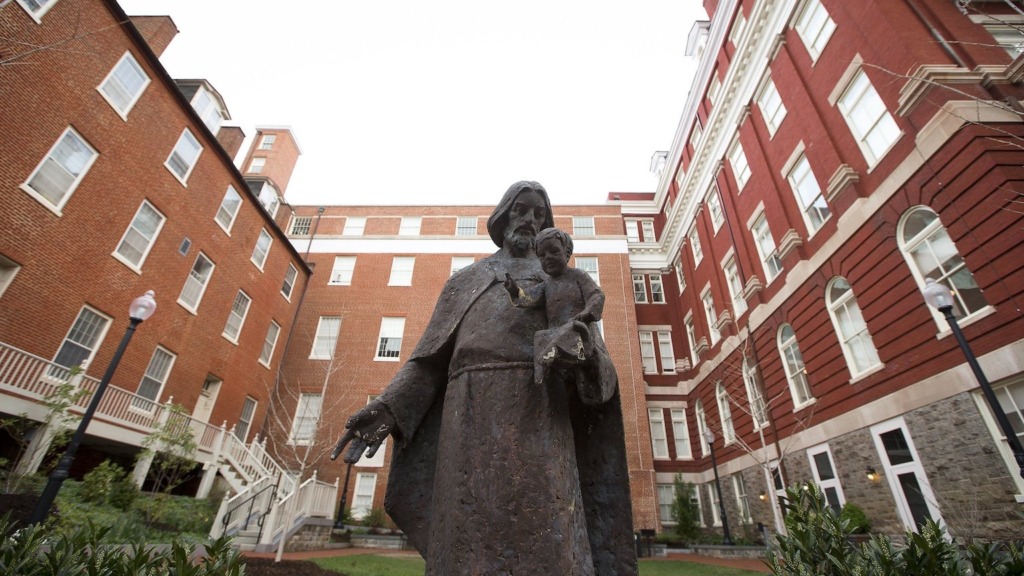WASHINGTON — The devastating impact of the sin of slavery cannot be fixed with a simple apology and monetary restitution, Georgetown University officials acknowledge.
The work began nearly seven years ago to begin to make amends for the school’s history of owning and selling enslaved people.
“Sometimes people will (ask) when will we finish up the reconciliation initiatives? (The answer is) it’s ongoing. It’s a permanent part of our process,” said Joseph A. Ferrara, vice president and chief of staff to the president of Georgetown University, one of the most recognizable Catholic institutions in the U.S.
It’s a shameful legacy the Jesuit-run university will bear for the foreseeable future, and there is no magic remedy to right the wrong, but Ferrara said university leadership is committed to continuing reparations to the descendants of enslaved people once owned by the Jesuits and to ongoing programs designed to counter systemic racism.
The efforts of Georgetown and the Jesuits to atone for what they label as a sin has been widely applauded as an example of how to begin the process of racial healing in a country still struggling to come to grips with racism.
However, these efforts don’t come without criticism from those who believe reparations send the wrong message and from some descendants of Georgetown slaves who say the committed restitution falls short of the damage that was inflicted.
‘Pillar of pro-slavery moral order’
The Jesuits opened Georgetown for classes in 1792, using profits from their slave-holding Maryland plantations to fund what is the oldest Catholic institution of higher learning in the U.S., said Adam Rothman, an associate professor of history at the university and author of “Slave Country: American Expansion and the Origins of the Deep South.”
“Georgetown’s history is a microcosm of the whole history of American slavery,” Rothman told Catholic News Service in a March interview. “The school was founded by a slave-holding Catholic elite. That group really stamped the school in its own image.”
Georgetown catered to that social class, educated boys and young men from that class and indoctrinated them with the moral judgments of that class, Rothman said, noting that the Catholic gentry and the Jesuits found a morality in enslaving other humans.
Documents and research find that not only did the profits from slave-holding plantations subsidize Georgetown, but slaves also worked on campus, students brought their own personal slaves to campus, and the students and faculty defended the institution of slavery in the years leading up to the Civil War and fought abolition efforts, he said.
“Georgetown – as the flagship educational institution of the Jesuits, of Catholic America in the early 19th century – was really a pillar of pro-slavery moral order,” Rothman said.
With a mounting debt in the late 1830s, Georgetown was on the brink of financial ruin.
So, in 1838 the Jesuits sold 272 enslaved men, women and children to two plantations in Louisiana and used part of the profits from that sale to rescue the college.
The Jesuits and Georgetown officials continued racial segregation policies long after slavery was outlawed in the U.S. and well into the 20th century.
Calls for reconciliation
By the end of the 20th century, however, the faculty began to research and teach about Georgetown’s role in slavery, Rothman said.
Students began to call on the university to address its racist past and by 2014 – as the country began to experience protests for racial justice – Georgetown officials knew it was time to act, Ferrara told CNS in a March interview.
“All of this flows under a construct that has guided our work,” he said, “which I would put sort of in three words, all of which begin with an a. Acknowledgment, apology and action.”
In 2015, Georgetown University President John DeGioia established the “Working Group on Slavery, Memory and Reconciliation.”
The working group’s efforts led to a formal apology from the Jesuits and the creation of the Descendants Truth & Reconciliation Foundation, announced in 2021 as a partnership formed by the Jesuits and the GU272 Descendants Association.
The Jesuit order pledged to raise $100 million for the foundation’s work, which will support educational opportunities and scholarships from early childhood education to higher education for descendants of the 272 enslaved men, women and children.
The foundation also will support community-based, grassroots and national programs that advance racial healing and transformation throughout the U.S.
The university has pledged to create a smaller reconciliation fund to support community groups that benefit descendants, Ferrara said.
Georgetown University also established a new Racial Justice Institute in 2021, which school officials say will serve as a hub where current and future scholars, activists and thought leaders may work across the academic, policy and advocacy spaces to address the remnants of slavery.
Robin Lenhardt, who is a professor at Georgetown Law and one of the founding faculty of this new initiative, said the Racial Justice Institute will focus on research and societal solutions for racial inequities in economic stability, housing, health, policing, education and a host of other areas.

